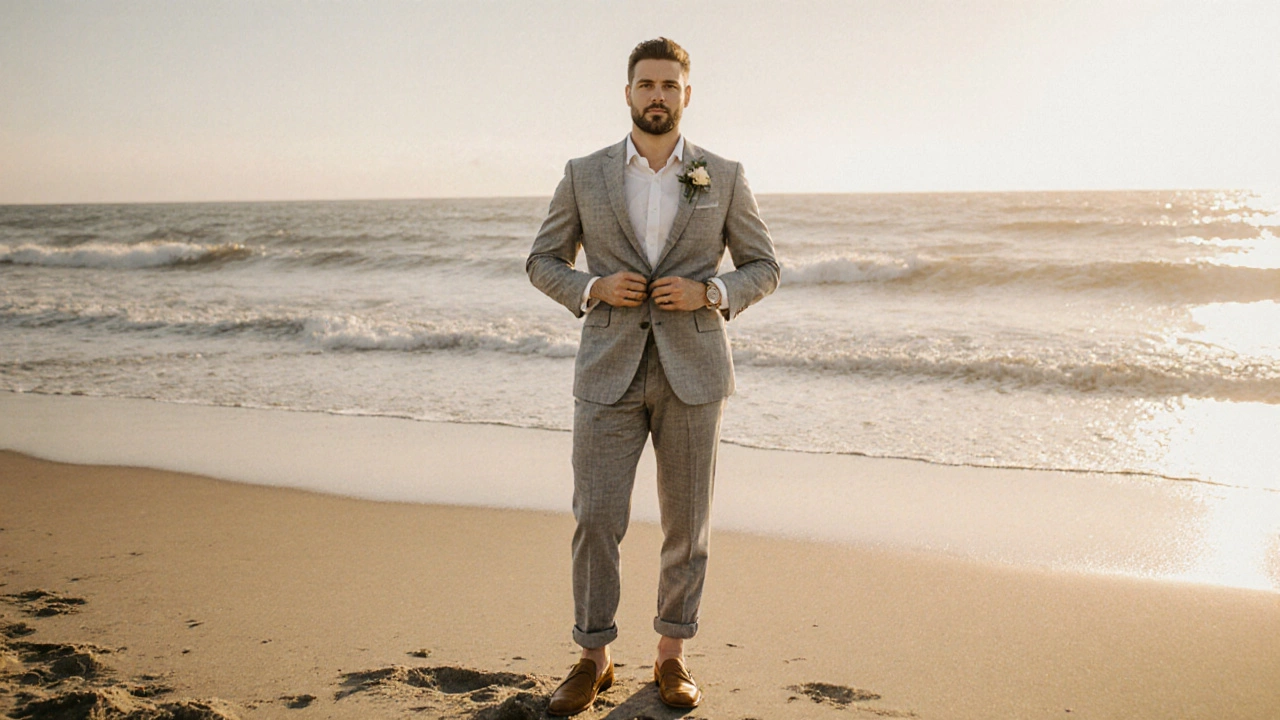Groom Suit Color Calculator
Choose the best suit color for your wedding based on season, venue, bride's dress, skin tone, and formality. We'll recommend options that match your wedding's style and make you look your best.
1. Wedding Season
2. Wedding Venue
3. Bride's Dress Color
4. Your Skin Tone
5. Wedding Formality
Your Recommended Suit Colors
Important Wedding Tip
Test your top choices in the actual wedding venue under daylight and evening lighting. Take photos in the suit. Ask two trusted friends: "Does this look like you?" If the answer isn't a confident "yes," try again.
Choosing the right suit color for the groom isn’t just about looking good-it’s about matching the vibe of the whole wedding. Too often, grooms pick black because it’s safe, only to realize it clashes with the venue, the season, or even the bride’s dress. The truth? The best suit color for the groom depends on the time of year, the setting, the wedding theme, and even the groom’s skin tone. There’s no single answer, but there are clear winners-and some colors you should avoid.
Black Suit: The Classic, But Not Always Right
Black suits are traditional, especially for evening weddings. They’re sharp, formal, and never out of style. But here’s the catch: black absorbs light. In outdoor daytime weddings, especially in summer, a black suit can make the groom look overheated and uncomfortable. It also doesn’t blend well with pastel or light-colored wedding palettes. If your wedding is at 7 p.m. in a ballroom with chandeliers, black works. If it’s a beach wedding at 4 p.m.? Skip it.
Also, black can make lighter skin tones look washed out. Grooms with fair skin and blue eyes often look better in navy or charcoal. Black works best on grooms with deeper skin tones or those wearing a black tuxedo with a white shirt and bow tie-classic, yes, but only if the whole look is intentional.
Navy Blue: The Smart Alternative
Navy is the most versatile suit color for grooms in 2025. It’s formal enough for black-tie events, yet relaxed enough for garden weddings. Unlike black, navy reflects light softly, making it ideal for outdoor photos. It pairs beautifully with cream, blush, sage, and even gold accents. Most importantly, it flatters nearly every skin tone.
A 2024 survey of 1,200 grooms by Wedding Style Magazine found that 68% chose navy for their main suit, and 89% said they were happy with the result. Why? Because it looks expensive without trying too hard. Navy also hides wrinkles better than lighter colors, which matters if you’re on your feet all day.
Pair navy with a crisp white shirt, a silk tie in a subtle pattern, and dark brown or black oxfords. If you want to go modern, try a navy suit with a light gray vest and no tie. It’s clean, stylish, and perfect for spring and fall weddings.
Charcoal Gray: The Understated Elegance
Charcoal gray sits between black and navy-it’s darker than light gray but not as intense as black. It’s the go-to for winter weddings, formal receptions, and venues with rich woodwork or dark walls. Charcoal has a quiet authority. It doesn’t compete with the bride’s dress, and it photographs beautifully in both natural and artificial light.
One thing to watch: charcoal can look too somber if the wedding has a bright, joyful theme. Avoid it for beach weddings, rustic barns with string lights, or colorful destination events. But for a winter ball, a city hall ceremony, or a museum wedding? Charcoal is flawless.
Style it with a light gray or ivory shirt, a patterned pocket square, and black or burgundy shoes. If you’re wearing a vest, match it to the suit. No need to over-accessorize-charcoal speaks for itself.

Light Gray: For Spring and Summer Weddings
Light gray is having a moment. It’s cool, fresh, and perfect for daytime weddings between April and September. It reflects sunlight instead of absorbing it, keeping the groom cooler and looking more relaxed. Light gray also pairs beautifully with floral arrangements, pastel bridesmaid dresses, and natural settings like vineyards or lakeside venues.
But here’s the warning: light gray shows dirt, sweat, and wrinkles easily. If you’re planning a long day of dancing or outdoor photos in hot weather, this might not be your best bet. It also doesn’t work well in low-light settings. A light gray suit in a dimly lit ballroom can look washed out.
Best used with a white or pale blue shirt, a silk tie in a muted tone, and tan or light brown shoes. Avoid black shoes-they clash. Stick to earth tones. And if you’re unsure, test the suit in the actual venue under the same lighting conditions as the wedding day.
Beige and Tan: Bold, But Only for the Right Wedding
Beige and tan suits are rising in popularity, especially for destination weddings in places like Santorini, Bali, or the Hamptons. They scream vacation, warmth, and ease. But they’re not for everyone. These colors work best on grooms with warm undertones in their skin and for weddings with a boho, rustic, or tropical theme.
Beige can look cheap if the fabric is thin or the cut is sloppy. Stick to wool or linen blends with a structured fit. Avoid beige if the wedding is formal, indoors, or during colder months. It looks out of place in a winter chapel or a downtown hotel.
Style beige with a white or cream shirt, a linen or silk tie in navy or olive, and brown loafers. Keep accessories minimal. A simple watch and no pocket square often work best. If the groom’s skin is pale or cool-toned, beige will make him look washed out. Skip it.
White and Off-White: Risky, But Stunning When Done Right
White suits are not for the faint of heart. They’re dramatic, elegant, and often reserved for summer beach weddings or very stylish destination events. Think: a groom walking down the sand in a crisp white linen suit, the sun behind him, the ocean glowing.
But here’s the reality: white shows everything. Sweat, stains, crumbs, pollen-it all shows up. And if the bride is wearing white, a white suit can accidentally make the groom look like a second bride. That’s not the look you want.
Off-white (ivory, champagne, cream) is a safer bet. It has warmth and depth, and it doesn’t compete with the bride’s dress. It also photographs better than pure white, which can blow out in sunlight. Use off-white only if the wedding is outdoors, in daylight, and the overall palette is neutral or earthy.
Pair with a natural fiber shirt, no tie, and suede or brown leather shoes. Add a simple boutonnière. This look is all about simplicity and confidence.

Colors to Avoid
Some colors just don’t belong on a groom, no matter how trendy they seem.
- Red-unless you’re in a culture where it’s traditional (like China or India), red screams attention, not elegance. It’s the bride’s color, not the groom’s.
- Purple-too bold, too dated. It reads as costume, not ceremony.
- Bright green or blue-these clash with most wedding palettes and can make the groom look like he’s from a different event.
- Patterned suits-stripes, checks, or florals are fine for rehearsal dinners, but skip them for the main ceremony unless you’re going for a very specific, high-fashion look.
How to Pick the Right Color for You
Here’s a simple decision tree to follow:
- What’s the season? Winter? Go navy or charcoal. Summer? Light gray or off-white. Spring/Fall? Navy or charcoal.
- Where’s the wedding? Beach? Light gray or beige. Church? Navy or charcoal. Garden? Navy or light gray.
- What’s the bride wearing? If she’s in ivory, avoid off-white suits. If she’s in white, avoid white suits. Navy works with everything.
- What’s your skin tone? Cool tones (blue veins, pinkish skin)? Navy or charcoal. Warm tones (green veins, golden skin)? Beige or light gray. Deep tones? Black or navy.
- How formal is it? Black-tie? Navy tuxedo. Semi-formal? Navy suit. Casual? Light gray or beige.
Test your top two choices in the actual venue under daylight and evening lighting. Take photos in the suit. Ask two trusted friends: "Does this look like you?" If the answer isn’t a confident "yes," try again.
Final Tip: Match the Mood, Not the Trend
There’s no "best" suit color for every groom. The best color is the one that feels like you and fits the day you’re celebrating. Don’t pick navy because it’s popular. Don’t skip black because it’s traditional. Pick what makes you feel calm, confident, and like the best version of yourself.
Remember: the groom’s suit isn’t the star of the day-it supports the bride, the moment, and the story you’re telling. Get it right, and no one will even notice the suit. They’ll just remember how happy you looked.
Can a groom wear a black suit to a daytime wedding?
Technically yes, but it’s not ideal. Black absorbs heat and looks heavy in daylight. It’s best reserved for evening weddings in formal venues. For daytime, navy or light gray are more comfortable and photogenic.
Is a navy suit too casual for a formal wedding?
No. Navy is the standard alternative to black for formal events. A well-tailored navy suit with a crisp white shirt, silk tie, and black oxfords is perfectly appropriate for black-tie or black-tie optional weddings.
Should the groom’s suit match the groomsmen’s?
Not necessarily. The groom should stand out slightly. A common approach is to have groomsmen wear the same suit color but in a different shade-like charcoal for the groom and navy for the groomsmen-or let them wear the same suit with different ties or accessories.
What shirt color goes best with a navy suit?
White is the safest and most classic choice. Light blue adds a soft contrast and works well for spring and summer. Avoid gray shirts with navy-it can look muddy. Stick to white or pale blue for the cleanest look.
Can I wear a patterned tie with a patterned suit?
Avoid it. Mixing patterns-like a pinstripe suit with a striped tie-creates visual chaos. If your suit has a subtle texture (like herringbone), pair it with a solid tie. If your suit is solid, you can use a patterned tie, but keep the scale different-small patterns with large ones.

